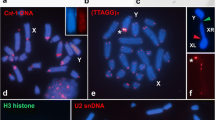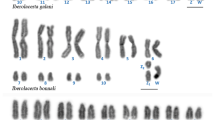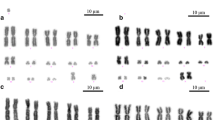Abstract
We report the results of a study on the neo-sex chromosome systems of six Neotropical Melanoplinae species for contributing to a better understanding of their origin and behaviour of these systems. Our analyses included detailed descriptions of the structure and behaviour of the sex chromosome configurations in male and female meiosis of species belonging to the genera Ronderosia, Dichromatos and Atrachelacris. Three species, R. forcipatus, R. malloi and A. unicolor, showed typical Robertsonian fusion-derived neo sex-chromosomes. However, the male metaphase I orientation of R. bergi sex pair indicated that more than one rearrangement was involved in its origin. The two species of Dichromatos presented a multiple neo-X1X2Y/X1X1X2X2 sex system, with two Robertsonian fusions involved in their genesis. Observations of female meiosis, confirmed the nature of the sex-chromosomes analyzed. Our results also showed different degrees of homology divergence between the neo-sex chromosomes and emphasize the plasticity of the chromosome complement of the Neotropical Melanoplinae to establish Robertsonian fusions and generate novel sex-chromosome systems. We also discuss karyotypic diversity within this group in terms of the centromeric drive theory of chromosomal evolution.








Similar content being viewed by others
References
Amédégnato C, Chapco W, Litzenberger G (2003) Out of South America? Additional evidence for a southern origin of melanopline grasshoppers. Mol Phylogenet Evol 28:115–119. doi:10.1016/S1055-7903(03)00074-5
Ashley T (2002) X-Autosome translocations, meiotic synapsis, chromosome evolution and speciation. Cytogenet Genome Res 96:33–39. doi:10.1159/000063030
Barlow BR, Wiens D (1976) Translocation heterozygosity and sex ratio in Viscum fischeri. Heredity 37:27–40. doi:10.1038/hdy.1976.63
Bidau CJ (1990) The complex Robertsonian system of Dichroplus pratensis (Melanoplinae, Acrididae). II Effects of the fusion polymorphisms on chiasma frequency and distribution. Heredity 64:145–159
Bidau CJ, Martí DA (2001) Meiosis and the Neo-XY of Dichroplus vittatus (Melanoplinae, Acrididae): a comparison between sexes. Genetica 110:185–194. doi:10.1023/A:1017908213431
Bidau CJ, Martí DA (2002) Geographic distribution of Robertsonian fusions in Dichroplus pratensis (Melanoplinae, Acrididae): the central-marginal hypothesis reanalysed. Cytogenet Genome Res 96:66–74. doi:10.1159/000063048
Bidau CJ, Martí DA (2004) B chromosomes and Robertsonian fusions of Dichroplus pratensis (Acrididae): intraspecific support for the centromeric drive theory. Cytogenet Genome Res 106:347–350. doi:10.1159/000079311
Carbonell CS, Mesa A (2006) Ronderosia ommexechoides: a new species of Brazilian Dichroplini (Orthoptera: Acrididae, Melanoplinae). Neotrop Entomol 35:632–637
Carbonell CS, Cigliano MM, Lange CE (2006) Especies de Acridomorfos (Orthoptera) de Argentina y Uruguay. CD ROM. Publications on Orthopteran Diversity. The Orthopterists Society at the Museo de La Plata, La Plata
Cardoso H, Sáez FA, Brum-Zorrilla N (1974) Location, structure and behaviour of C-heterochromatin during meiosis in Dichroplus silveiraguidoi (Acrididae, Orthoptera). Chromosoma 48:51–64. doi:10.1007/BF00284866
Cardoso H, Dutra A (1979) The Neo-X Neo-Y sex pair in Acrididae, its structure and association. Chromosoma 70:323–336. doi:10.1007/BF00328770
Castillo ERD (2008) Neo-Sistemas de Determinación Sexual en Especies de Melanoplinos Neotropicales (Melanoplinae, Acrididae) Universidad Nacional de Misiones. MSc thesis
Colombo P, Cigliano MM, Sequeira AS, Lange CE, Vilardi JC, Confalonieri VA (2005) Phylogenetic relationships in Dichroplus Stål (Orthoptera: Acrididae: Melanoplinae) inferred from molecular and morphological data: testing karyotype diversification. Cladistics 21:375–389. doi:10.1111/j.1096-0031.2005.00068
Charlesworth B (1996) The evolution of chromosomal sex determination and dosage compensation. Curr Biol 2:149–162. doi:10.1016/S0960-9822(02)00448-7
Charlesworth BW, Wall JD (1999) Inbreeding, heterozygote advantage and the evolution of neo-X and neo-Y sex chromosomes. Proc R Soc Biol Sci Ser B 266:51–56. doi:10.1098/rspb.1999.0603
Charlesworth D, Charlesworth B, Marais G (2005) Steps in the evolution of heteromorphic sex chromosomes. Heredity 95:118–128. doi:10.1038/sj.hdy.680069
Díaz M, Sáez F (1968) DNA Synthesis in the NeoX Neo-Y sex determination system of Dichroplus bergi (Orthoptera: Acrididae). Chromosoma 24:10–16. doi:10.1007/BF00329603
Eades DC, Otte D (2009) Orthoptera species file online. Version 2.0/3.5. Retrieved from http://Orthoptera.SpeciesFile.org 30/5/2009
Grützner F, Rens W, Tsend-Ayush E, El-Mogharbel N, O’Brien PCM, Jones RC, Ferguson-Smith MA, Graves JAM (2004) In the platypus a meiotic chain of ten sex chromosomes shares genes with the bird Z and mammal X chromosomes. Nature 432:913–917. doi:10.1038/nature03021
Henriques-Gil N, Jones GH, Cano MI, Arana P, Santos JL (1987) Female meiosis during oocyte maturation in Eyprepocnemis plorans (Orthoptera: Acrididae). Can J Genet Cytol 27:84–87
Hewitt GM (1976) Meiotic Drive for B-chromosomes in the primary oocytes of Myrmeleotettix maculatus (Orthoptera: Acrididae). Chromosoma 56:381–391. doi:10.1007/BF00292957
Hewitt GH (1979) Orthoptera. Grasshoppers and crickets. In: John B (ed) Animal cytogenetics vol. 3. Insecta 1. Gebrüder Borntraeger, Berlin, p 170
King M (1993) Species evolution. The role of chromosome change. Cambridge University Press, Cambridge, p 336
Martí DA, Bidau CJ (1995) Male and female meiosis in a natural population of Dichroplus pratensis (Acrididae) polimorphic for Robertsonian translocations: A study of chiasma frecuency and distribution. Hereditas 123:227–235. doi:10.1111/j.1601-5223.1995.00227
Martí DA, Bidau CJ (2001) Synapsis in Robertsonian heterozygotes and homozygotes of Dichroplus pratensis (Melanoplinae, Acrididae) and its relationship with chiasma patterns. Hereditas 134:245–254. doi:10.1111/j.1601-5223.2001.00245
Mesa A (1962a) Cariología de Dichroplus bergi Stål (Orthoptera: Acrididae). Rev Agric 37:41–47
Mesa A (1962b) Los cromosomas de Eurotettix lilloanus Lieb(Orthoptera, Catantopidae). Acta Zool Lilloana 18:99–104
Mesa A, de Mesa RS (1967) Complex sex-determining mechanism in three species of South Amenican grassshoppers (Orthoptera, Acridoidea). Chromosoma 21:163–180. doi:10.1007/BF00343642
Mesa A, Ferreira A, Carbonell CS (1982) Cariología de los acridoideos neotropicales: estado actual de su conocimiento y nuevas contribuciones. Annls Soc Ent Fr 18:507–526
Mesa A, Fontanetti CS, Garcia-Novo P (2001) Does an X-autosome centric fusion in Acridoidea condemn the species to extinction? J Orthoptera Res 10:141–146
Palestis BG, Burt A, Jones RN, Trivers R (2004) B chromosomes are more frequent in mammals with acrocentric karyotypes: support for the theory of centromeric drive. Proc R Soc Lond B Suppl 271:S22–S24. doi:10.1098/rsbl.2003.0084
Pardo-Manuel de Villena F, Sapienza C (2001) Female meiosis drives karyotypic evolution in mammals. Genetics 159:1179–1189
Rufas J (1985) Contribución de las técnicas de impregnación argéntica al estudio de los cromosomas de Ortópteros. In: Gosálvez J, López Fernández C, García de la Vega C (eds) Orthoptera vol. 1. Fundación Ramón Areces, Madrid, pp 227–255
Sáez FA (1963) Gradient of the heterochromatinisation in the evolution of the sexual system “neo-X-neoY”. Port Acta Biol Ser A 7:111–138
Sáez FA, Pérez-Mosquera G (1977) Structure, behaviour and evolution of the chromosomes of Dichroplus silveiraiguidoi (Orthoptera, Acrididae). Genetica 47:105–113. doi:10.1007/BF00120174
Schmid M, Steinlein C, Feichtinger W (1992) Chromosome banding in Amphibia. XVII. First demostration of multiple sex chromosomes in amphibians: Eleutherodactylus massi (Anura, Leptodactylidae). Chromosoma 101:284–292. doi:10.1007/BF00346007
Smith SG, Virkki N (1978) Coleoptera. In: John B, John B (eds) Animal cytogenetics vol. 3. Insecta 5. Gebrüder Borntraeger Berlin, Stuttgart, p 366
Steinemann M, Steinemann S (1998) Enigma of Y chromosome degeneration: Neo-Y and Neo-X chromosomes of Drosophila miranda a model for sex chromosome evolution. Genetica 102(103):409–420. doi:10.1023/A:1017058119760
Sumner AT (1972) A simple technique for demonstrating centromeric heterochromatin. Exp Cell Res 75:304–306
Talbert PB, Bayes JB, Henikoff S (2009) Evolution of centromeres and kinetochores: a two-part fugue. In: De Wulf P, Earnshaw WC (eds) The kinetochore. From molecular discoveries to cancer therapy. Springer, New York, pp 103–230
Tanuja MT, Ramachandra NB, Ranganath HA (1999) Evolution of a recent neo-Y sex chromosome in a laboratory population of Drosophila. J Genet 78:81–85. doi:10.1007/BF02924559
White MJD (1973) Animal cytology and evolution. Cambridge University Press, Cambridge
White MJD, Blackith RE, Blackith RM, Cheney J (1967) Cytogenetics of the viatica group of Morabine grasshoppers. The “coastal” species. Aust J Zool 15:263–302
Acknowledgments
The authors are very grateful to María Marta Cigliano for introducing us to the fascinating world of Ronderosia and allies. We also wish to especially acknowledge Prof. Pavel Borodin (Novosibirsk, Russia) for his critical reading of a previous version of the manuscript. This research was partially supported by FONCyT PICTO 37035 BID 1728/OC-AR to DAM. DAM acknowledges the continuous support of Consejo Nacional de Investigaciones Científicas y Técnicas (CONICET), Universidad Nacional de Misiones. ERC is PhD candidate at Universidad Nacional de Córdoba (Doctorado en Ciencias Biológicas) and is very grateful to all people in our laboratory and to CEDIT for postgraduate scholarship. CJB acknowledges the support of CNPq (grant 480596/2007-7), FAPERJ (grant APQ1 3225/2007) and IOC/FIOCRUZ, all institutions from Brazil.
Author information
Authors and Affiliations
Corresponding author
Additional information
Dedicated in fond memory of Prof. Alejo Mesa, pioneer in the study of Neotropical chromosomal diversity of grasshoppers.
Rights and permissions
About this article
Cite this article
Castillo, E.R.D., Bidau, C.J. & Martí, D.A. Neo-sex chromosome diversity in Neotropical melanopline grasshoppers (Melanoplinae, Acrididae). Genetica 138, 775–786 (2010). https://doi.org/10.1007/s10709-010-9458-8
Received:
Accepted:
Published:
Issue Date:
DOI: https://doi.org/10.1007/s10709-010-9458-8




